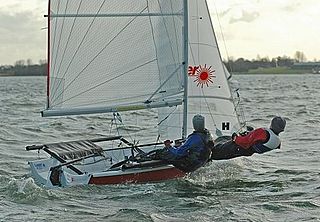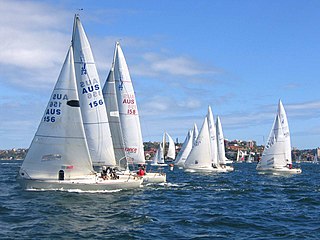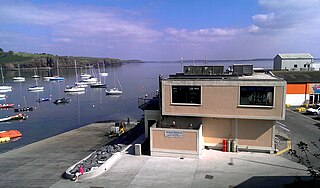Related Research Articles

Cruising by boat is a lifestyle that involves living for extended time on a vessel while traveling from place to place for pleasure. Cruising generally refers to trips of a few days or more, and can extend to round-the-world voyages.

A yacht is a watercraft used for pleasure or sports. The term originates from the Dutch word jacht, and originally referenced light, fast sailing vessels that the Dutch Republic navy used to pursue pirates and other transgressors around and into the shallow waters of the Low Countries. The yacht was popularized by Charles II of England as a pleasure or recreation vessel following his restoration in 1660.

Dinghy sailing is the activity of sailing small boats by using five essential controls:

Dinghy racing is a competitive sport using dinghies, which are small boats which may be rowboats, have an outboard motor, or be sailing dinghies. Dinghy racing has affected aspects of the modern sailing dinghy, including hull design, sail materials and sailplan, and techniques such as planing and trapezing.

The Laser, is a highly popular family of small one-design sailing dinghies using the same common hull and interchangeable rigs with different sail areas. The laser is designed to be sailed single handed although class rules permit two sailors. Bruce Kirby designed the laser in 1970 with an emphasis on simplicity and performance.

Sir Charles Benedict Ainslie, CBE is an English competitive sailor.
One-Design is a racing method which may be adopted in sports which use complex equipment, whereby all vehicles have identical or very similar designs or models. In motor racing, it is also known as one-make racing and spec racing.

The Laser 4000 is a well known racing dinghy crewed by two persons. Its one-design weight-equalised system enables physically differing sailors to compete on a level playing field. It is most popular in Europe, particularly the UK, France and Italy.

Hebe Haven Yacht Club established in 1963, is a private members club located in the picturesque bay of Pak Sha Wan in Sai Kung District, Hong Kong. The Commodore is CK Chan and the General Manager is Lisa Keatley.
Sail Canada is Canada's governing body for the sport of sailing. Sail Canada is a "Member National Authority" of the International Sailing Federation (ISAF). Organization of sailing in Canada is divided into four groups: yacht clubs, Provincial Sailing Associations, class associations, and Sail Canada itself.
The Inter-Collegiate Sailing Association (ICSA) holds National Championships in six different categories: Women’s Single-handed, Men’s Single-Handed, Match Racing, Women’s Dinghy, Coed Dinghy, and Team Racing. Since college sailing is a fall and spring sport, three of these championships are held in the fall and three are held in the spring. The college team that compiles the best overall record in the six categories is awarded the Leonard M. Fowle Trophy.
Fairey Marine Ltd, latterly known as FBM Marine, was a boat building company based on the River Hamble, Southampton, England. The company was created in the late 1940s by Sir Charles Richard Fairey and Fairey Aviation's managing director, Mr. Chichester-Smith. Both were avid sailing enthusiasts along with Chichester-Smith's good friend and former Olympic yachtsman, Charles Currey.
The Glenmore Sailing Club (GSC) promotes and provides sailing-related Education, Recreation, Racing and Social Events for people of all ages and abilities in Calgary and surrounding communities.
RS Sailing is an international designer, builder and supplier of sailboats and dinghies and associated goods and services supported by a worldwide dealer network and class associations.

The sport of sailing involves a variety of competitive sailing formats that are sanctioned through various sailing federations and yacht clubs. Racing disciplines include matches within a fleet of sailing craft, between a pair thereof or among teams. Additionally, there are specialized competitions that include setting speed records. Racing formats include both closed courses and point-to-point contests; they may be in sheltered waters, coast-wise or on the open ocean. Most competitions are held within defined classes or ratings that either entail one type of sailing craft to ensure a contest primarily of skill or rating the sailing craft to create classifications or handicaps.
Mark Mendelblatt is an American yachtsman. Married to Carolina Borges He primarily sails the Laser, a one-design class of small single-handed sailing dinghy. Beginning in 2005, he also started to race in the two-person keelboat Star class.

Waterford Harbour Sailing Club is situated in Dunmore East in the west side of Waterford Harbour. It is the largest sailing club in South East Ireland and has a membership of 400. The club was founded in 1934 at Dunmore East and occupies a location beside the slip in the Harbour. The present clubhouse was built in 1969 and was extended in 1974. The club is affiliated to the Irish Sailing Association.
Caprera is an island in the Maddalena archipelago off the coast of Sardinia, Italy.
The Hunter 54 is an American sailboat that was designed by Warren Luhrs, John Cherubini and Cortland Steck as a cruiser and first built in 1980. The design was based upon three years of off-shore racing experience.

The Topper Topaz is a British single-handed or two-handed sailing dinghy that was designed as a beginner and intermediate racer.
References
- ↑ di Sambuy, Vittorio (8 January 2009). "La nascita del CVC" [Birth of the CVC]. AltoMareBlu (in Italian).